| Wildlife | Plants | Berries | Mushrooms | National Parks |
Swedish forests and meadows are abundant of delicious berries. In the height of summer, Swedes invade the forests with sturdy boots and mosquito spray to fill their baskets. In old times it was important to have a source of vitamins and minerals for the long winter, but today, with the grocery’s plentiful assortment of tropical fruits and vegetables from all over the world, this is no longer an important aspect. Nowadays berries are picked just for the fun of making your own jam, pie, jelly, compote or soup, and for the pleasure of the outdoor experience. And, of course, for the delight of eating the berries, fresh from the bush, in a dessert, or as a condiment with your meatballs!
The most plentiful, the Swedish Blueberry, is easily found almost anywhere and can be made to all children’s absolute favorite jam, eaten with pancakes and whipped cream. This berry is mostly used for desserts and cakes since it is so sweet. Even more common on Swedish tables is the jam made from Lingonberries. Bright red, tangy and sweet, it is served not only as a condiment with all kinds of meat, such as steaks, meatballs and bacon but also with cheesecake, ice cream and other desserts. However, the King of all berries is, however, the Cloudberry – fresh from the bog where you picked it, with double cream, or on vanilla ice cream… or as jam with a piece of fried Camembert – there’s nothing like it!
And there are a lot of other delicious Swedish berries to be found in the greenery, such as Arctic Bramble, Wild Raspberries, and Wild Strawberries – not always so easy to find, but a bliss when you’ve found them. And did you know that a delicious dessert can be made of roses? Well, not by the rose flower itself, but from the rosehip?
If you should visit Sweden in July or August, why not try it yourself? Get out in the woods and fill a small basket! It’s easy and rewarding. The only question you may have is, of course, where are you allowed to pick berries? The answer is simple: anywhere. At least almost anywhere. To understand what’s allowable and what’s not, you should learn a few things about the ancient Swedish customary law called “Allemansrätten”.
Now, knowing your rights and obligations you are ready to roam the countryside to fill your basket full of Swedish berries and mushrooms! Check out below for the amazing berries you can find in Sweden.
Cloudberries
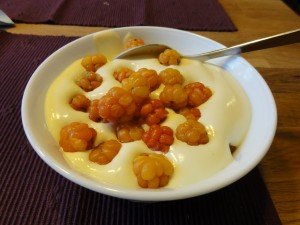
Nothing is so satisfying as the tangy, juicy treat of cloudberries. When I’m not inclined to trudge through a swampy bog to swipe these puppies straight off the bush, I’m inclined to refine my culinary prowess by finding new and sumptuous recipes that integrate the cloudberries, or, research and uncover additional information about this superior-to-a-raspberry-or-blackberry fruit. Never in a lackluster year living in the United States was I ever privy to such a divine fruit as the cloudberry; and similarly, there are few if any berries in the world with a comparable monetary value (not that it’s easy to put a price tag on sweet, flavorful bliss). Now I’m able to satisfactorily squelch my desires for a tangy, flavorful fruit.
Lingonberries – “Lingon”
Lingonberries (Vaccinium vitis-idaea) belong to the same genus as Swedish blueberries. Lingonberry jam (“lingonsylt”) is a veritable staplefood in the Swedish kitchen. Like blueberries, lingonberries are quite abundant in the Swedish forests, growing on low, evergreen shrubs. The small pink flowers open in May, and the bright red berries can be picked from late July.
Lingonberries have some similarity to their distant relative the cranberry, but they are much smaller, juicier and more tart. To put it simple, lingonberries are sour. They contain a lot of vitamins (A, B- and C) and minerals (such as potassium, calcium, magnesium and phosphor) and also natural preservatives. In the old times this meant a lot because to preserve a bucket of lingon the entire winter, the only thing you need to do is fill it up with fresh water to cover the berries!
Alternatively, you can stir the raw berries with a small amount of sugar (or a big amount, depending on your taste), and you have a tasty lingonberry jam, no cooking required! This jam is called “rårörda lingon”, i.e. “raw stirred lingonberries”. Most of the jam sold in grocery stores is however boiled and “diluted” with red currants and/or apples, to make it cheaper. Look for the text “Rårörd lingonsylt” to get the best kind.
The zesty lingonberry jam (“rårörda lingon”) adds an interesting twist to many dishes and you can find it served with almost anything: Swedish pancakes, granola, porridge, cheesecake (delicious!), as a salad mixed with shredded carrots or cabbage, with meatballs, bacon, roast. It’s really a staple food, and most Swedes don’t think a lot of it, except when it’s missing with their meatballs. “Morsan! Var är lingonsylten?” (Mom! Where’s the lingonberry jam?)
The taste of lingonberries is also appreciated in other ways: as a beverage (“lingondricka”), as a cocktail (vodka with ice and lingondricka goes under the name “Vargtass”, which means wolf’s paw), in cakes and bread, in akvavit, and in pickled herring. It’s really a very versatile berry.
Possible confusion: Lingon has a look-alike, called “mjölon” (Arctostaphylos uva-ursi), that can be mistaken for unusually big lingon. However, there’s no need to worry: mjölon are edible, but totally tasteless. A few mjölon in the lingonberry jam makes no difference. Mjölon are juiceless; the inside is starchlike, like meal (“mjöl”).
Swedish Blueberries – “Blåbär”
Actually, you cannot find blueberries in Sweden. But there is an abundance of “blåbär”. Even if the Swedish name “blåbär” literally translated means “blue berries”, it’s a different species than the American blueberry.
The English name for Swedish blueberries is bilberry. But most Swedes have never heard the name “bilberry”, so they’ll just give you a funny look if you ask for bilberries: Blue … Berries … Are … Blueberries. I’ll stick to that in this text.
Blåbär, i.e. Swedish blueberries (Vaccinium myrtillus) are closely related to American blueberries (Vaccinium corymbosum) and look the same on the outside, just a little smaller. Both species have a similar taste, but Swedish blueberries have a little more tart and character since they contain a little less sugar. Usually the berries appear to be light blue, covered with a thin waxy film, but when this is lacking, the color is actually dark blue, almost black. An important difference is that the inside of an American blueberry is white, whereas the inside of a Swedish blueberry is burgundy red, and the juice is purple. Thus Swedish blueberries will tint your fingers blue / purple, as well as your lips, your tongue and your clothes – be careful! The color is easily washed off from your skin but not so from your garments.
Blueberry brushwood has light green leaves and is usually 20 – 50 cm high. It’s abundant all over Sweden and covers as much as 17% of the total areal. The tiny purple flowers open in May or June, and ripe berries can be found from late July., easy to pick in large quantities.
Swedish blueberries are sweet and savory, soft and very juicy. It’s a very versatile fruit that can be used to make pie, jam, jelly, marmalade, wine, soup, and tea, or eaten as they are, maybe with sugar and cream. By the way, blueberry jam is delicious with Swedish pancakes and whipped cream!
Blueberries and blueberry brushwood are an important food source for bears, moose, deer, capercaille (the large black European grouse) and several other species of birds. They are very rich in nutrients, vitamins, and antioxidants, and are often sold dried as power food or functional food.
Humongous quantities of warm blueberry soup are consumed in one day when served along the track as an energy drink to the participants in Vasaloppet, which is the world’s longest cross country ski race (90 km ~ 56 miles). The race usually attracts about 16,000 contestants every year. Many skiers, especially the not-so-good skiers who often stop for a drink, reach the finish line with a purple chest. (That’s the reason why a beginner is called “ett blåbär” in Swedish.)
Bog Bilberries – “Odon”
Bog bilberries (Vaccinium uliginosum), called “Odon” in Swedish, belong to the same genus as the Swedish blueberry. They can be found in the same places as blåbär, but as indicated by the English name, more often on bogs. The flowers are white, the berry is blue, often somewhat bigger than a Swedish blueberry, and slightly oval in shape. Odon are edible but the taste is rather bland, why they seldom are picked deliberately. They can easily be discerned from blueberries by the darker color of the leaves, and by the fact that the inside of the berry is pink, not burgundy red. Unknowingly, blueberry jam (“blåbärssylt”) often contains a few odon, but you can’t tell the difference.
The only known use of bog bilberries in Sweden is that very long ago, they were used for making a beverage called “solvin” (sun wine). The recipe for this was quite simple: sugar was dissolved in water, crushed “odon” were added, the jug was left in open sunlight for about three weeks, whereafter the berries were strained off, and it was ready for consumption. It must have had a certain alcoholic content, but the flavor is unknown.
The name “odon” may mean that it belongs to Odin, the “allfather” god in Norse mythology.
Blingon or blågon – hybrid of blueberries and lingon
Being a knowledgeable reader, you have figured out that since blåbär and lingon both are of the same genus, Vaccinium, there must be hybrids.
Yes, you’re right, there is a hybrid, it’s called “blingon” or “blågon”. It is important only by providing a topic to fill newspaper pages during the summer’s news drought, with reports of sensational findings.
It is highly unlikely that you should stumble over a blingon/blågon plant, they are after all rather rare. If you do, take a picture, but don’t bother to pick the berries if there are any. This only proves that good parents don’t always get good children.
Raspberries – “Hallon”
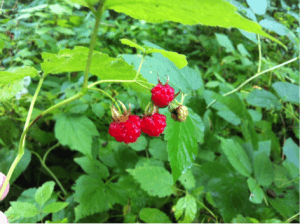
The raspberry can be found in Norrland. Not to be mistaken for the cloudberry, raspberries, as commonly known, are red in color whereas the cloudberries are yellow in color.
Raspberries (Rubus idaeus) are a sure children’s favorite. Several cultivated varieties are common in Swedish gardens, and they have an almost magnetic attraction to all children in the vicinity. Now that’s easy to understand – raspberries are sweet, soft and juicy, they taste good, and even smell good. Garden raspberries are often high-yielding and fairly easy to pick from the bush; the thorns are very small, rather soft, easily avoided and do not really make harm. As long as there still are raspberries left on the bush, that’s where the kids are.
If you don’t have raspberries in your garden – or even a garden – you can find all the raspberries you want in the forest, all over Sweden. Wild varieties grow in abundance on many places, preferably on arid slopes, cairns, clearings, and forest edges. The thicket is often very dense and offers some resistance to the picker, but even if the thorns on the wild variety are bigger, they’re not big enough to make real wounds; they’re more an irritating factor. The small and humbly white or light green flowers open in May, and ripe berries can be found all summer, from late June.
Not many Swedes go out to pick wild raspberries, even if they are rather easy to find. The wild raspberries are much smaller than the garden varieties, the bushes are thorny, and raspberry jam is readily available in any store. But there’s still quite a few people that fight the irritating thorny bushes to fill their buckets. The reason for their efforts is the taste: like any wild berry, wild raspberries are sweeter and have stronger aroma, agreeably pungent. If you don’t eat them all at once with a little sugar and cream, they will make a jam that’s far better than the one that’s industrially produced.
Arctic bramble – “Åkerbär”
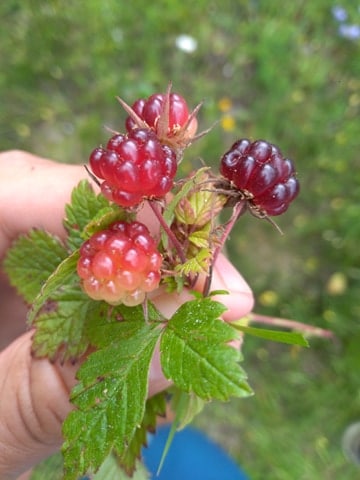
In his journal Flora Lapponica, the Swedish botanist Carolus Linnaeus described his hardships during his journey to Lapland, A.D. 1732. His aim with the trip was to name and describe the arctic flora and fauna. One of the plants he named, and highly praised, was Rubus arcticus, “åkerbär” in Swedish. Linnaeus writes that at times when he was succumbing by fatigue, these berries, “with their wine-like flavor”, gave him back his strength.
(The legendary Carolus Linnaeus, later ennobled Carl von Linné, created the modern scheme of binomial nomenclature and is considered as one of the fathers of modern ecology. He was one of the most acclaimed scientists in Europe: in a message, the Swiss philosopher Jean-Jaques Rosseau wrote that he knew no greater man on earth, and the German writer Johann Wolfgang von Goethe wrote about Linnaeus, “except Shakespeare and Spinoza, no human had influenced me more”.)
The Swedish name “åkerbär” means “field berry”. As the English name suggests, this is a plant that prefers the arctic regions. Growing in moist grassland it can be found mostly in the northern half of Sweden, but it appears sparsely as far south as in the northern tip of Värmland. However, as far south as that, the berries often do not ripen.
Although closely related to raspberry and belonging to the same genus, it’s a low and delicate plant. The flowers have the color of pink roses; the berries are dark red, sweet and juicy. The flavor resembles a mix of raspberries and wild strawberries. The jam is described as “celestial”, by those who are lucky to have tasted it.
The only sad thing with arctic bramble is that it’s rather sparse, even in Norrland. Thank you Rikki Franklin Frederiksen for providing us an image of this plant!
(By the way: the Finnish liqueur Mesimarja is made from arctic bramble. However, it doesn’t really reflect the taste of the berries, neither do liqueuers made from cloudberries and raspberries. Recommendations are therefore: if you find them, eat the berries fresh or as jam, and if you want that dizzyness, have a glass of wine afterwards.)
Blackberries and dewberries – “björnbär”and “blåhallon”
Blackberries (Rubus fruticosus / plicatus) are common enough not to need a description. Known in Sweden as björnbär, meaning “bear’s berries”, they grow wild only in the southmost counties and along the coastline up to Stockholm.
A closely related species is dewberries (Rubus caesius), in Sweden called “blåhallon” or “salmbär”; they look and taste almost like raspberries but are blue. Like blackberries they can be found along the southernmost coasts, especially on the island of Gotland, where “salmbärssylt” (dewberry jam) is considered as a local specialty, served on waffles with whipped cream.
Cranberries – “Tranbär”
I sincerely doubt that cranes bother to eat cranberries (Vaccinium oxycoccus and Vaccinium microcarpus), but the Swedish word “tranbär” also translates to “crane’s berries”. Like blåbär and lingon they belong to the genus Vaccinium (forest shrubs) in the family Ericacae (heather plants).
In Sweden, cranberries (V. oxycoccus) and dwarf cranberries (V. microcarpus) grow wild on bogs in northern regions. These subspecies are smaller than the species found in North America (V. macrocarpus and V. erythrocarpus) but have the same taste and other characteristics.
Rowanberries – “rönnbär”
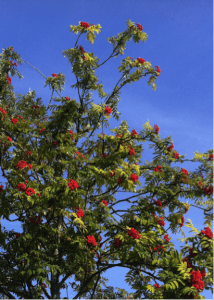
An old Swedish saying goes ”De är sura, sa räven om rönnbären.” (They are sour, said the fox about the rowanberries). This saying is used as a mockery of jealousy: when someone talks bad about something he wants but cannot reach.
The rowan (Sorbus aucuparia) is a small tree that carries clusters of small white flowers in May/June and an abundance of bright orange-coloured berries in the fall.
The saying is true: rowanberries are very sour when eaten fresh. The acidity is all you can feel. But if you wait until there has been a night with frost, something happens: behind the sourness is a faint aroma, quite agreeable and useful in the kitchen. But you may not get the chance to taste a frost-bitten rowanberry – many birds love them, especially waxwings. These pretty birds migrate in late fall from Sweden to the British islands; on their way, they come in large flights and clear the rowan trees from berries. So if you really want to try rowanberries, you’ve better pick a few clusters before the waxwings have taken them all, and emulate the frosty night by letting the berries spend a few days in the freezer.
However, rowanberries are never eaten as is. Instead, they are converted to a delicious jelly, usually served with roast of moose or deer, or any roast, even a turkey.
Another way to make use of rowanberries is to make rönnbärsbrännvin (rowanberry akvavit). Fill a big bottle with rowanberries from the freezer, then fill it up with vodka (try the red Absolut, 60° proof), and forget it for three or four weeks. Strain the liquid, add a pinch of sugar, and you have a mild orange/pink akvavit that goes well with any dish. Alternatively, you can mix it with bar syrup to make a liqueur with a quite unique, mild and pleasant taste.
Elder – “fläder”
The elder bush (Sambucus nigra) grows wild in the southern half of Sweden. It carries flat clusters of small white flowers in June and black berries in early autumn. You can boil the berries with sliced lemons, add sugar, strain the liquid, and you’ll get a dark red drink that tastes nice, diluted with water. But it’s not really worth the trouble.
Instead you can easily make a wonderful drink from the flowers, “fläderblomssaft” (elder flower juice): Fill a big bucket with elder flowers, add a couple of sliced lemons for acidity, add a kg of sugar or two for sweetness, fill the bucket with boiling hot water and wait until next day before straining the contents. If necessary, add more sugar. The resulting drink smells like flowers and tastes like flowers. On a hot summer day, an ice cold glass of this drink with clinking ice cubes, served in the shade, is quite incomparable to quench your thirst. The kids will love it.
In the afternoon, for the grownups, add a spoonful of fläderblomssaft to a glass of cold white wine with an ice cube or two, and … enjoy.
Just make sure that what you are picking comes from the black elder. There is a related species, red elder (Sambucus racemosa, druvfläder in Swedish) which you should avoid, since it’s mildly poisonous and doesn’t taste good. It is very easy to discern the two: red elder, that you must avoid, has egg-shaped clusters of flowers (and red berries in egg-shaped clusters), while the black elder has flat clusters of flowers (and black berries in flat clusters).
Rose hips – “nypon”
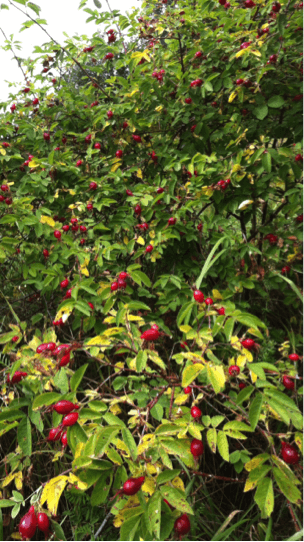
Roses are common in gardens in any country, so also in Sweden. But different species or varieties also grow wild in meadows, dells and along roads, with large numbers of orang rose hips (“rose hip” = ”nypon” in Swedish) in the fall. A common wild species is Rosa dumalis (“nyponros” in Swedish).
In the old days, it was quite common to collect rose hips and turn them into nyponsoppa (rose hip soup), an orange to light brown sweet dessert soup, rich in vitamin C. Nyponsoppa is popular also today as a snack, dessert, or for breakfast, often served with cream, and sometimes with small almond cookies floating in the bowl.
It’s not difficult to pick rose hips and make your own nyponsoppa, but now you can find several brands of nyponsoppa in any grocery, so only the most confirmed nyponsoppa-lovers make their own.
…and there are many others…
There is also a number of other wild berries that aren’t so common. Almost all are edible even if they don’t taste much – the only exception that comes to my mind is the berries from lily of the valley: these are poisonous, but their bright orange color can look tempting for small children and may become a reason for a fast ride to the Emergency Room.
Looking for berry picking supplies? Purchase one of these products below and help support our website!
No products found.

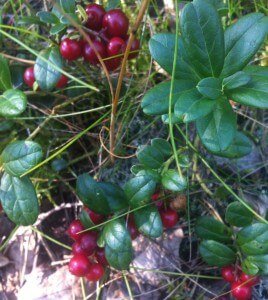
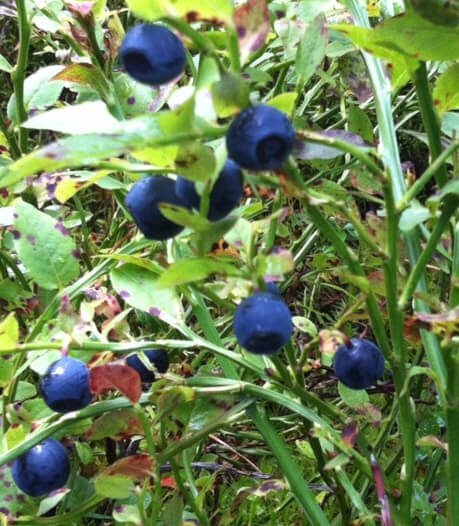
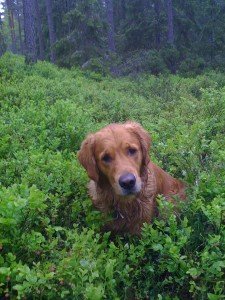
Loved it. Thank you very much for taking the time to explain in so much detail. So looking forward to my picking adventure this summer 🙂 Now to find the best spots… 😉